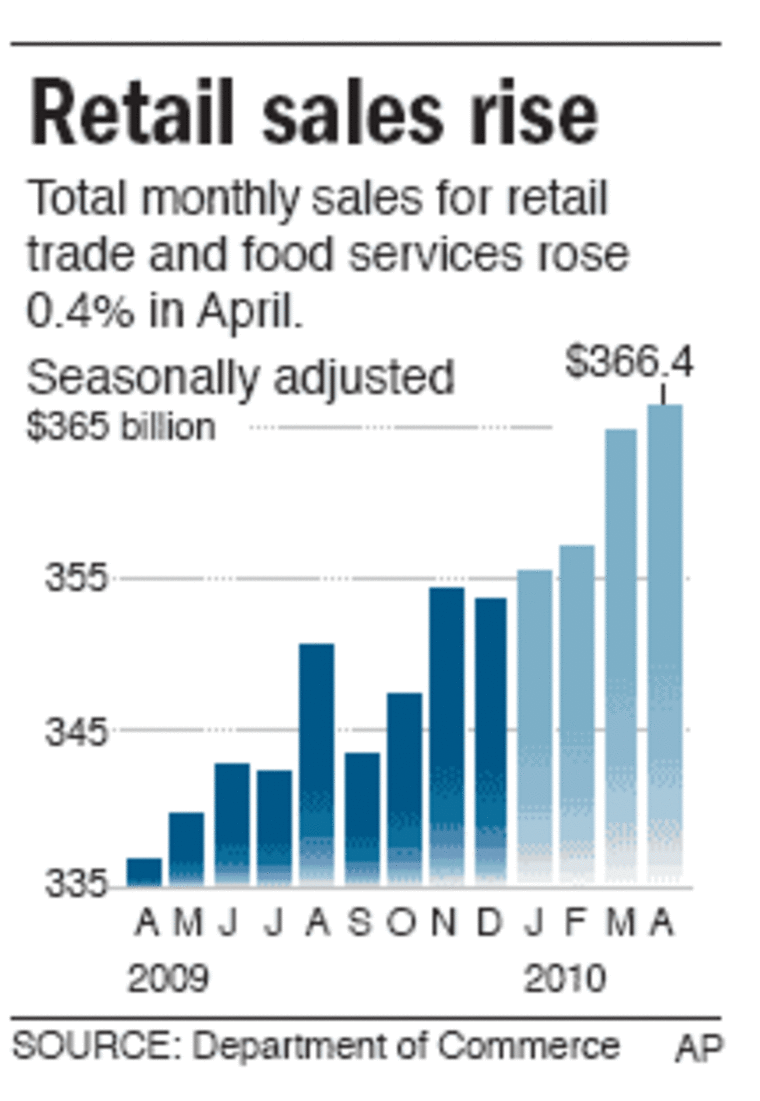U.S. retail sales rose and industrial production powered ahead in April, further evidence the economic recovery was strengthening.
Consumers were also a bit more confident early this month, adding to Friday's string of upbeat data that stood in sharp contrast to financial markets which sold off as panicky investors worried about Europe's debts.
Though the debt crisis is expected to have a minimal impact on U.S. economic activity, analysts worry falling share prices could dampen consumer morale and crimp household spending.
"While the economic recovery is on a very sound footing, I am apprehensive about some of the noise coming out of Europe," said Craig Thomas, a senior economist at PNC Financial Services in Pittsburgh.
Sales at U.S. retailers climbed 0.4 percent after rising 2.1 percent in March, the Commerce Department said. April's increase was double what markets had expected and marked the seventh straight monthly gain.
Separately, the Federal Reserve said industrial production rose 0.8 percent last month after a 0.2 percent increase in March. The gain exceeded market expectations for a 0.6 percent increase and highlighted the factory sector's lead role in the economy's recovery from the worst recession since the 1930s.
Capacity utilization, a closely watched measure of how fully the economy is using its productive potential, rose to 73.7 percent, the highest since November 2008, from 73.1 percent in March.
The U.S. central bank has listed resource use among factors it is monitoring to determine when to begin raising benchmark interest rates, which stand effectively at zero.
Chicago Federal Reserve President Charles Evans said uncertainty triggered by the Greek debt crisis underscored the need to keep U.S. interest rates low for an extended period.
"I think that the risks, obviously, with the global situation make things a little bit more uncertain than we were expecting," he said. "So, if anything, I am even more comfortable with my assessment that accommodation continues to be important."
Consumers feeling more confident
A rebuilding of inventories from record low levels by businesses has largely driven the recovery, but consumers are now taking part and growing more optimistic.

The Thomson Reuters/University of Michigan's Surveys of Consumers' sentiment index rose to 73.3 in May from 72.2 in April, a touch below market expectations.
"Robust production and restocking will spill over to the broader economy via the labor market, household and business sentiment. This dynamic will help sustain growth," said Aaron Smith, a senior economist at Moody's Economy.com.
U.S. markets largely ignored the data, focusing on worries that heavy government debt burdens in Europe could curb growth in the region. U.S. stocks tumbled, with the Standard & Poor's 500 index dropping more than 2 percent.
Prices for U.S. government debt rallied, while the dollar rose to a more than 18-month high against the euro.
Recent data have pointed to a fairly solid foundation for the U.S. recovery, although an expected slowdown in Europe may prove a headwind.
A Philadelphia Federal Reserve Bank survey of forecasters published Friday forecast the economy growing at a 3.3 percent rate in both the second and third quarters, up from an earlier poll.
The economy grew 3.2 percent in the first quarter and analysts expect a modest upward revision as export and retail sales growth in March were stronger than previously estimated.
Increase in auto sales
Sales last month were supported by a surprise rise in motor vehicle purchases, as well as an increase in building materials and garden equipment receipts. Excluding autos, sales rose 0.4 percent last month after rising 1.2 percent in March.
However, a measure corresponding most closely with the consumer spending component of the government's gross domestic product report — a gauge that strips out autos, gasoline and building materials — slipped 0.2 percent. It had risen 0.7 percent in March.
Analysts remain upbeat on the prospects for spending.
"The fact that the economy now appears to be creating jobs at a healthy clip has improved the outlook for consumer spending," said Paul Dales, a U.S. economist at Capital Economics in Toronto.
But businesses have some worries. Department store operator J.C. Penney gave a modest profit forecast for both the second quarter and the full year, and the chief executive said spending remained tentative.
Strengthening domestic demand saw U.S. business inventories increase in March to their highest level in eight months, the Commerce Department said in a second report.